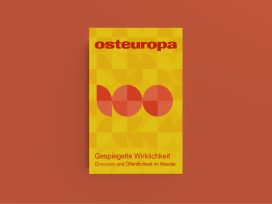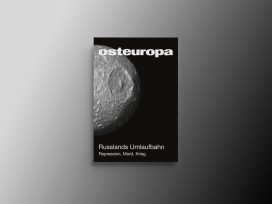Abstracts Osteuropa 5/2006
Ulrich Schmid
Nasi – the Putin youth. Soviet Tradition and Political Conceptual Art in Russian Youth Organizations
For years, the Putin administration has been trying to give its political youth work a modern image. The long-term goal is to create a patriotic, pro-government youth organization that will see to it that a loyal political climate exists in society. After the failures of a traditional youth party and the potentially scandalous movement Common Path, the rigidly hierarchical youth organization Nasi (Ours) was called into being with considerable financial resources. This movement unites features of the Soviet-era Komsomol with activities clearly inspired by dissident conceptual art of the 1970s and 1980s.
Hermann Clement
Economic boom instead of bust. Russia’s upturn under the Microscope
Like the phoenix from the ashes, Russia’s economy has risen from the severe crisis brought on by transformation. Fantasies of economic great power status are already taking shape. But the upturn is based primarily on the high cost of energy around the world. This carries with it the risk of Russia being infected by the “Dutch disease”. Russia’s economy is heavily reliant on exports of oil, gas, and raw materials. State-dominated monopolization is increasing. This promotes corruption and reduces opportunities for economic growth. Investment is too low; the middle class is not developing quickly enough. Future risks such as insufficient education and research capacities alongside a high percentage of old people are not taken seriously enough. The first indications of the reforms needed to remedy these weaknesses can be made out, however.
Stefan Wellgraf
Gifts of millions. Oligarchs and football in Ukraine
The success of numerous football clubs depends on sponsorship from members of the business elite. These donations are not altruistic gifts, but aim to mobilize other resources in fields unrelated to sports. Manchester United, Juventus Turin, AC Mailand, and Red Star Belgrade are examples of this phenomenon. Meanwhile, oligarchs from eastern Europe have also been getting involved in football. In Ukraine, Rinat Akhmetov sponsors Shakhtyor Donetsk. This is part of the functional logic behind the Donetsk Region’s clientele rule. Providing support for Dynamo Kiev or Chelsea London as well as clubs in Russia feeds on other motives. The oligarchs are trying to accumulate social capital, so as to stabilize their precarious legal position.
Winfried Schneider-Deters
Free elections, big problems. An Orange pyrrhic victory in Ukraine?
During the elections in Ukraine, the Party of Regions polled the best results. But three of the parties that emerged from the Orange Revolution, taken together, enjoy an absolute majority. Forming an Orange coalition, however, is proving to be a difficult task. The reason is Yulia Tymoshenko’s claim to the premiership. Powerful elements within the presidential bloc Nasha Ukraina are resisting this. President Viktor Yushchenko is showing weak leadership. Participation of the Party of Regions in a government poses a risk to Ukraine’s independence: Due to the dependence of eastern Ukrainian coal, iron, and steel magnates on gas from Russia, the Party of Regions in a “grand coalition” with Nasha Ukraina would drive the integration of Ukraine into the “single economic space” proposed by Russia and jeopardize Ukraine’s EU prospects.
Ervin Csizmadia
Star Search Hungary. The 2006 parliamentary election
For the first time since the first free elections in 1990, a Hungarian government has been confirmed in office. The reason for this is the governing MSZP’s successful communication policy and an election campaign centred on the person of Minister President Ferenc Gyurcsány. By contrast, the strategy pursued by the opposition FIDESZ party to create a right-wing coalition around its chairman, Viktor Orbán, has failed. In the coming years, the government will be unable to get around far-reaching economic reforms, while the opposition faces considerable upheaval in terms of personnel and programme.
Jan Kusber
Two solutions to a problem. The Soviet Union and 1956 in Poland and Hungary
Fifty years after the 20th Party Congress of the Communist Party of the Soviet Union and Moscow’s decisions to grant the people’s democracies in Hungary and Poland two very different degrees of leeway for their social development in the critical year 1956, the Soviet leadership’s options for action deserve to be reconsidered. Made within a few days, the decisions to meet the challenges to the system in Poland and Hungary with political pressure and military force respectively were open right up to the end. They revealed the deep sense of unease produced by de-Stalinization.
Malte Rolf
Presenting empire and representing regionalism. Sport parades and regional festivals under Stalinism
Under Stalinism, imperial presentations and regional representations existed alongside one another. This coexistence was loaded with conflict. This was also expressed in festival practices. The Bol’sheviki, as in an empire, tried to implement in the regions norms directed from the centre. One instrument for presenting the empire was the sport parade. By contrast, local party elites made efforts to propagate regional consciousness with regional festivals. The regional idiom even came to facilitate the communication of Soviet ideals at the regional level.
Karlheinz Kasper
Maidenhair. Mikhail Shishkin’s “Intellectual Novel”
In the past few years, several Russian novels have appeared that represent the type of book Thomas Mann called the “intellectual novel”. After Vladimir Makanin (Underground, or A Hero of Our Times), Oleg Yur’ev (The Zhidiatin Peninsula) and Viktor Pelevin (Dialectics of the Period of Transition from Nowhere into Nothing), Mikhail Shishkin, who has been living in Switzerland since 1995, has published Maidenhair, one of the most artistically demanding efforts of the genre. This still untranslated novel is highly controversial in Russia, but has received a major prize for literature.
Pavel Poljan
Compass for the archipelago. The Gulag in documents: New territory for research
Solzhenitsyn moulded our view of Stalinist terror in the image of the Archipelago GULag. A seven-volume document collection of previously unpublished source material, Istoriya stalinskogo Gulaga helps reveal in systematic fashion the gigantic system of Soviet forced labour camps. Files from Russian archives provide insight into the structures, goals and operation of the NKVD-MVD repression apparatus and documents prison conditions and resistance efforts. The victims’ perspective is largely excluded from official documents and statistics, but this collection does include forms of repression such as deportation.
Published 14 June 2006
Original in German
Contributed by Osteuropa © Osteuropa
PDF/PRINTNewsletter
Subscribe to know what’s worth thinking about.



